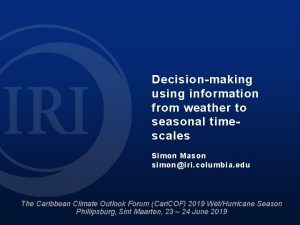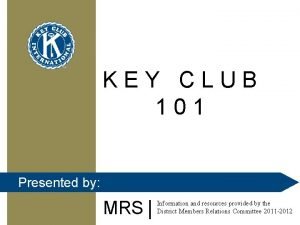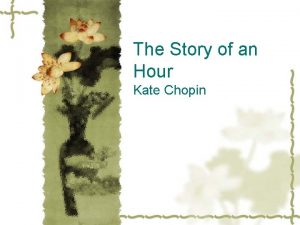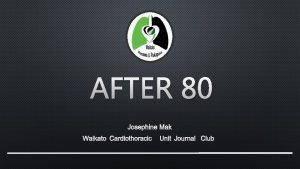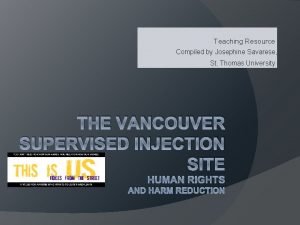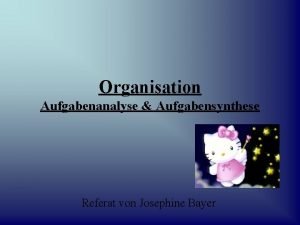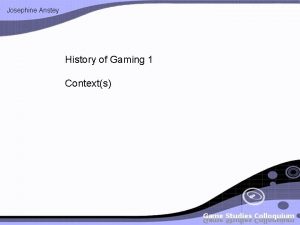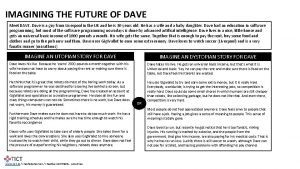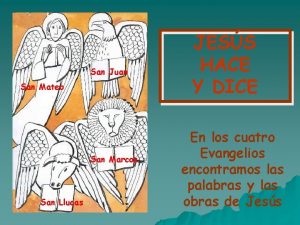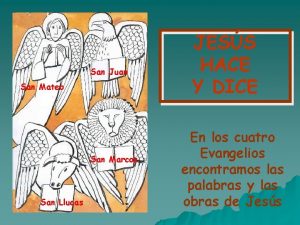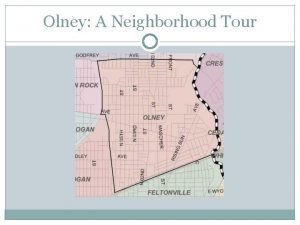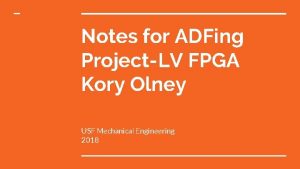Josephine San Dave Olney 18 August 1999 15













- Slides: 13

Josephine San Dave Olney 18 August, 1999 15 July 1999 NASA/GSFC/IMDC

Appears to be Feasible Requirements Coarse Pointing baselined on NGST Future technology Control modes Area of concerns 15 July 1999 NASA/GSFC/IMDC 2

Pointing Requirements on Optical Spacecraft ACS ¥ Accuracy (1 s) : © Course (with tracker) Pitch/Yaw ± 2. 0 arcsec; Roll 20 arcsec © Fine (long term drift) pitch/yaw ± 0. 5 marcsec ¥ Jitter © Coarse © Fine ± 0. 1 arcsec ± 0. 1 marcsec Pointing Requirements on Detector Spacecraft ACS Stability (1 s) : ¥ Lateral Stability ¥ 15 July 1999 (1 s) : Pitch/Yaw ± 20 arcsec; Roll 20 arcsec 3 mm NASA/GSFC/IMDC 3

Rate null/Sun Acquisition: null rates, point arrays normal to sun Sensors : Coarse Sun Sensor, Gyro ¥ Actuator: options: large wheel/small wheel + good PAF/thruster ¥ Acquisition: acquire stars to establish reference attitude Sensors: HD 301 Star tracker(ST), Fine Sun Sensor (FSS), gyro (ring laser) ¥ Actuator: same as rate null/sun acquisition ¥ Science: inertial pointing Sensors: coarse pointing - ST, FSS, gyro; Fine pointing - instrument ¥ Actuator: options: /large wheel with thruster/PPT/small wheel with PPT ¥ Slew: eigenaxis rotation capability Sensor: gyro ¥ Actuator: options: wheel/PPT ¥ Safehold: independent safe mode, same as sun acquisition 15 July 1999 NASA/GSFC/IMDC 4

Detector ACS mode scenarios Rate null/Sun Acquisition: null rates, point arrays normal to sun ¥ Sensor same as Optics spacecraft; actuator can be wheel or thruster Initial Acquisition: acquire stars to establish reference attitude ¥ Sensors same ad Optics spacecraft’s acquisition; actuator same as sun acquisiton Science: inertial pointing Pointing: same as optics spacecraft coarse pointing ¥ Lateral control: laser and PPT ¥ Slew: Acquire optics spacecraft, acquire new target Sensor: gyro ¥ Actuator: wheel or thruster ¥ Delta V - Re-acquire new target position Safehold: independent safe mode, same as sun acquisition 15 July 1999 NASA/GSFC/IMDC 5

Actuator Selection Criteria Quantization - Science requirement Disturbance torque - Science requirement Torque Capability - slew and solar torque Momentum capability Tip off rate ¥ Solar pressure at drift orbit ¥ © Solar force is about 0. 2 m N © Assuming 0. 1 meter cp offset for optics spacecraft, Solar torque is 20 micro Nm © In one day the momentum build up is about 1. 8 Nms 15 July 1999 NASA/GSFC/IMDC 6

Optics - sun acq/rate null Large wheel (80 Nms) Tip off rate less than 0. 05 deg/sec ¥ Imbalance torque disturbance ¥ Weight and Power ¥ Small wheel (40 Nms)+ PAF Assuming with good PAF, tip off rate less than 0. 01 deg/sec ¥ 40 Nms wheel ¥ Weight and Power ¥ Thruster PPT is not sufficient to null the rate (0. 01 deg/sec) and acquire the sun ¥ hydrazine - Sloshing problem ¥ Cold gas - only choice ¥ 15 July 1999 NASA/GSFC/IMDC 7

Optics - SCIENCE PPT only ¥ ¥ ¥ ¥ ¥ Better quantization* No need to unload momentum* No heritage yet, EO 1 will have one axis PPT control as test Need 12 PPT with no redundancy* Mass, power, cost Limited number (10 million) of firing (fire every 3 s for 1 year) Plume impingement Electro-magnetic contamination Need to further investigate items without ‘*’ 15 July 1999 Wheel with isolation; thruster for momentum unloading ¥ ¥ ¥ ¥ NASA/GSFC/IMDC Quantization Need to unload momentum* Has heritage* Longer life time* With four wheel provides redundancy* Mass, power, cost Imbalance torque disturbance Same as PPT last item 8

Optics - Science (con’t) Small wheel with isolation /PPT ¥ Wheel for pointing, PPT for momentum unloading © Finer quantization of wheel © Extend PPT life time ¥ Wheel for coarse pointing, PPT for fine pointing and momentum unloading © Better quantization for fine pointing © Extend PPT lifetime ¥ Depend on the actuator induced disturbance and other studies 15 July 1999 NASA/GSFC/IMDC 9

Optics - Slew Wheel Less than 6 hours to slew 45 degree ¥ Remain a zero-momentum system ¥ PPT 12 hours to slew 45 degree ¥ After the slew, the system momentum may not be zero ¥ 15 July 1999 NASA/GSFC/IMDC 10

Technology New Generation Integrated Wheel and electronic all integrated ¥ Low noise, low imbalance torque, low power ¥ Spartan 400 series and Triana heritage ¥ New Generation Star Tracker NGST heritage ¥ Accuracy 1. 35 arcsec accuracy per star ¥ Pulse Plasma Thruster ¥ As three axis fine control actuator 15 July 1999 NASA/GSFC/IMDC 11

PPT concerns Plume impingement, EMI, Life time ¥ Maintain a zero momentum system ¥ A better solar torque estimation Tracking strategy of optics and detector spacecraft Fine pointing Strategies Operation scenarios post separation Null rate before separate two spacecraft ¥ Rate after two spacecraft separation ¥ What is the rate after two spacecraft separation ¥ 15 July 1999 NASA/GSFC/IMDC 12

Component (wheel option) 15 July 1999 NASA/GSFC/IMDC 13
